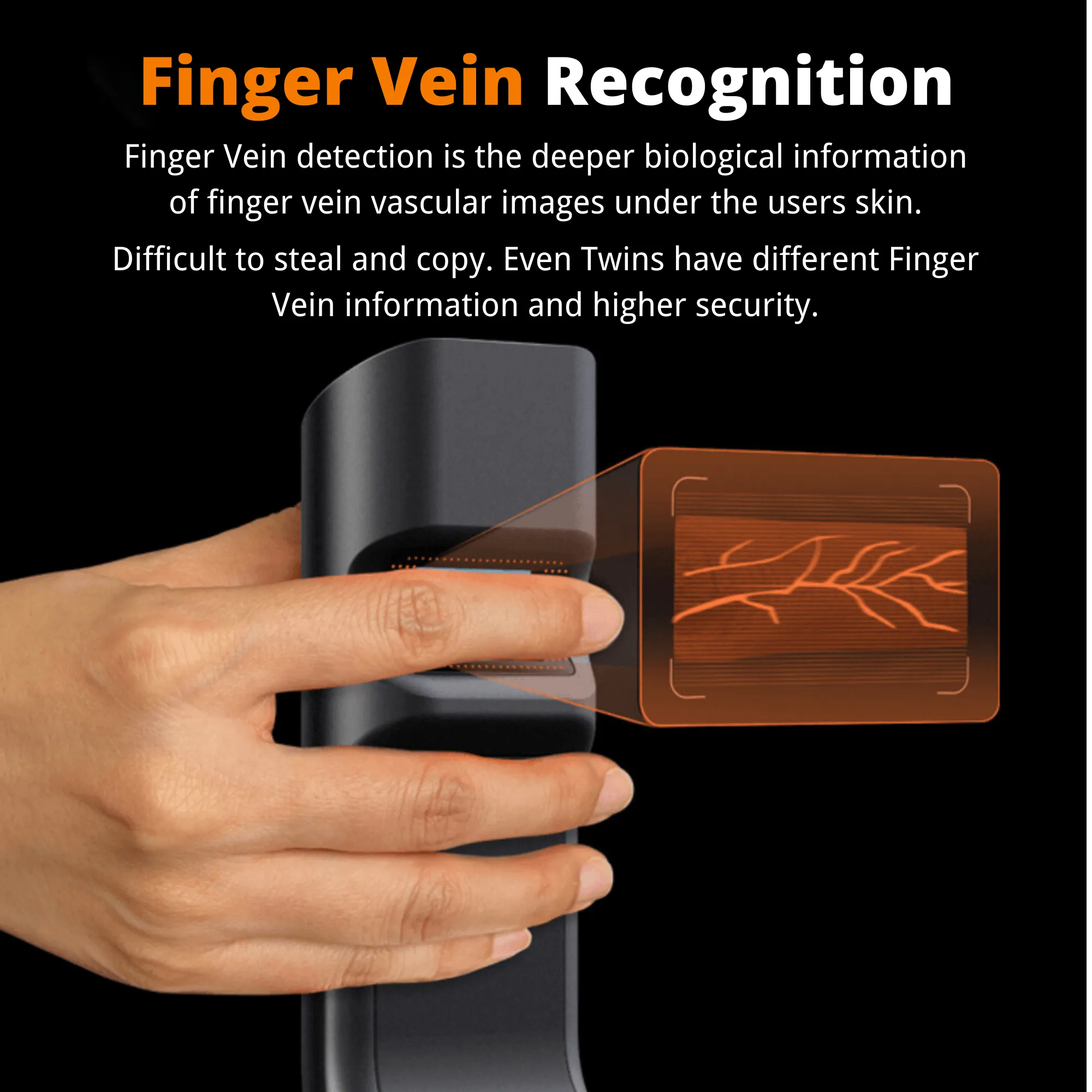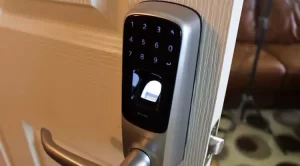Smart door locks are often the first smart products many users encounter in their smart homes. In India , most newly constructed buildings are equipped with pre-installed smart door locks or electronic door locks. As smart door locks continue to gain popularity, criminals attempt to bypass their security using various methods. Traditional electronic door locks or regular smart door locks, excluding smart cards or backup keys, typically offer only fingerprint and passcode unlocking options. However, fingerprints can be forged or easily stolen, while passwords are a primitive authentication method that can be stolen or cracked, resulting in lower security. On the other hand, advanced and newer smart door locks incorporate updated unlocking technologies, including finger vein recognition, facial recognition, virtual passcode, and more. Among them, finger vein recognition is considered the most secure unlocking method. This Nexmot article aims to provide an in-depth understanding of how finger vein recognition, as a new technology, operates and enhances the security of smart door locks.
Key Highlights of this Article:
- What is biometric recognition?
- What is finger vein recognition?
- Advantages of vein recognition
- Why is finger vein recognition safer for smart door locks compared to fingerprints?
- Are there any drawbacks to finger vein recognition in smart door locks?
What is biometric recognition?
Finger vein recognition is a top-tier biometric recognition technology. To understand what finger vein recognition is, it’s necessary to first comprehend biometric recognition technology. Biometric recognition technology utilizes human physiological characteristics that are intrinsic and lifelong, such as fingerprints, finger vein patterns, facial features, iris, or certain behavioral traits like handwriting, voice, and gait. Through computer analysis, these characteristics are used to identify individuals.
What is Finger Vein Recognition?
As mentioned above, finger vein recognition is one of the biometric identification technologies. Simply put, finger vein recognition uses a CCD camera to capture near-infrared light with a wavelength range of 700 to 1100 nm to obtain finger vein pattern images. These images are then compared with pre-stored finger vein patterns to identify individuals.
How Finger Vein Recognition Works?
Since the blood flowing in the human finger can absorb light of specific wavelengths, illuminating the finger with near-infrared light allows for clear imaging of finger veins. The computer analyzes the finger vein pattern image, extracts eigenvalues, and applies techniques such as wave filtering and image binarization to obtain mathematical representations of the finger vein pattern. These representations are stored and used for future comparison when identifying individuals.
If a finger has no blood flow, it cannot absorb light of specific wavelengths. In other words, fake or lifeless fingers cannot be successfully recognized. The finger being recognized must be connected to a living human body, just like a living “internal passcode.”
Advanced smart locks now come equipped with finger vein recognition, which can significantly enhance the security of your home.
Advantages of Finger Vein Recognition
There are many types of biometric identification technologies, such as facial recognition and iris recognition. However, finger vein recognition is considered the most secure and reliable biometric identification technology for several reasons, which Nexmot will explain one by one:
Recognition of Life
As mentioned above, a finger with no blood flow cannot absorb light of specific wavelengths, making it impossible to capture and use finger vein patterns for identification. This means that the finger being recognized must be connected to a living human body, making it impossible for independent or fake fingers to impersonate someone. Facial recognition or fingerprint recognition based solely on surface features can be deceived by stealing fingerprints or creating fake facial images using non-living objects.
Internal Features
When using finger vein recognition for identity verification, the internal vein pattern features of the finger are utilized instead of surface features. This makes it difficult to steal and ensures that finger abrasions, injuries, dryness, or moisture do not affect finger vein recognition. Hence, finger vein recognition is often referred to as the “inner code.” Even within the same person, the finger vein patterns in different fingers are unique. Moreover, finger vein patterns are highly stable, and they generally do not change in healthy adults.
Unique Finger Vein Patterns
Medical research has proven that finger vein patterns are unique and individual-specific. The extracted images of finger vein patterns differ for each person. Even within the same person, the finger vein patterns in different fingers are distinct. Additionally, finger vein patterns are highly stable, and they generally do not change in healthy adults.
Contactless Recognition
Since a CCD camera emits near-infrared light to capture finger vein patterns, there is generally no need for hands or fingers to physically touch the recognition device. Simply placing the finger to allow the near-infrared light to illuminate it is sufficient. This eliminates the need for the specific techniques required for fingerprint recognition, and contactless operation ensures better hygiene in public applications.
Small File Storage Size and Fast Recognition
Due to the stability of finger vein patterns, CCD cameras can easily capture finger vein images without requiring high-resolution lenses. Therefore, the file size of captured finger vein pattern images is naturally smaller, requiring less storage capacity. Simultaneously, during the recognition process, the comparison of images can be performed faster.
High Accuracy
As mentioned above, finger vein patterns are internal features, reducing the possibility of interference during image capture and resulting in more accurate recognition. Additionally, statistics indicate that the False Rejection Rate (FRR) of finger vein recognition, i.e., denying a legitimate identity, is below 0.01%. The False Acceptance Rate (FAR), i.e., accepting an unauthorized identity, is below 0.0001%. The Failure to Enroll Rate (FTE), representing recognition failure, is 0%.
Therefore, as the first line of defense for homes, smart locks equipped with finger vein recognition can greatly enhance home security.
Smart Door Locks – Why is Finger Vein Recognition Safer than Fingerprint?
Traditional fingerprint recognition requires complete contact for capture and identification, which is not only unhygienic but also vulnerable to unauthorized individuals obtaining fingerprints from various sources and creating fingerprint molds. This makes fingerprint recognition highly susceptible to security breaches. Since people touch countless objects with their hands and fingers every day, it is practically impossible to prevent fingerprint theft unless one wears gloves consistently.
However, fingerprints can be stolen not only from surfaces commonly touched by users. In fact, if a high-definition camera captures a photo while someone is making the commonly used “V” victory gesture, the fingerprints become clearly visible, making it incredibly easy to obtain them. For high-profile individuals who are frequently exposed or interviewed, the risk of fingerprint theft is significantly higher.
Finger vein recognition, on the other hand, doesn’t encounter these issues. Finger vein patterns are internal features that do not leave traces even if fingers come into contact with objects. It is highly unlikely to capture finger vein patterns through photography. Additionally, finger vein recognition relies on capturing images of finger vein patterns through the absorption of near-infrared light by blood flow. Even if someone manages to leak finger vein patterns (which is extremely difficult), unauthorized individuals would need to create a device that mimics blood flow and appropriate vein patterns to impersonate someone’s identity. However, duplicating finger vein patterns with current technology is considered highly challenging.
Therefore, finger vein recognition is undoubtedly more secure than traditional fingerprint recognition, offering faster and more accurate results. If you are considering purchasing a smart door lock, it is worth considering options equipped with finger vein recognition, such as Nexmot M10 and Z09 series. They will undoubtedly provide faster and more secure unlocking experiences.
Are there any downsides to finger vein recognition smart door locks?
Every technology or product has its pros and cons, and the same goes for finger vein recognition smart door locks. As the saying goes, you get what you pay for. Finger vein recognition requires a CCD camera, emits short-wave infrared light, and incorporates sophisticated recognition and matching technologies. Consequently, smart door locks equipped with finger vein recognition tend to be relatively higher in price.
Moreover, the camera and the device for collecting finger vein patterns are inevitably larger and less compact than accessories used for fingerprint collection. Therefore, smart door locks with finger vein recognition tend to have a larger size, requiring more space for installation. This is especially relevant when dealing with iron gates, where accurate measurements of available space become crucial.
After reading this Nexmot article, we believe you have gained a deeper understanding of finger vein recognition and why finger vein recognition smart door locks are currently the safest and most reliable option. If you have any questions about transforming your home into a smart home, feel free to contact Nexmot via WhatsApp for free professional advice or visit the Nexmot showroom to experience Real Smart Home.



